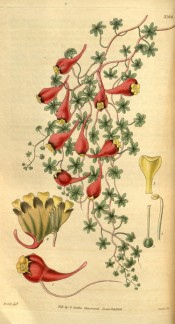Raising Tropaeolum tricolor from seed
The Victorian gardening literature is full of usefull advice on how to propagate and look after plants, usually written by people actually doing the work rather than merely writing about it. This anonymous article, written by ‘a practitioner’ is an excellent example. The directions are clear, concise and easy to follow. Some of the materials mentioned will be unfamiliar to the modern reader, but there should be little difficulty in deciding on an appropriate modern equivalent. This article, ‘Raising Tropaeolum tricolorum from seed’, was published in the Floricultural Cabinet, edited by the nurseryman Joseph Harrison, in 1853.
Many of our readers are aware of the great difficulty of getting seeds of this plant to vegetate. I have practiced the following method for several years with constant success. Take the seeds and place them in the pans belonging to the pots commonly used in gardens, filled with water, and let them soak for two or three days, till the shell which surrounds the interior of the seed will come easily off. After removing the shell, which requires to be done with great nicety, or you will injure the principal point of the seed, prepare some pots, filled with some good rich compost, composed as follows: two parts good decayed leaf-mould, one part hazel loam, and the fourth part of equal portions of bog-earth and sand, which mix well together; fill the pots about three parts full, or rather more, of this mixture; then place the seeds on the top, (not too many, or you will not be able to remove the plant after it has formed a tuber,) and fill the remaining part with fine white sand, giving it a gentle pressing. Then remove the pots to the cool greenhouse, and place them in as shady a place as you possibly can, without anything being close to them. Keep the pots always in a damp state; but mind when you sow the seed to place plenty of drainage at the bottom. As soon as some of the plants appear above the soil about one or two inches, take a small stick, and lift the seed from the soil, moving as little as possible the other soil, or you will injure the remaining seeds. Pot the the young plants into the size pots called thumbs, which afterwards treat the same as for old plants in a growing state. The seedlings thus raised will flower the succeeding summer, and the year following make good established plants. [FC p.181/1853].
This method works well, but should you experience difficulty in sourcing hazel loam or bog-earth, a standard, moisture-retaining but well drained seed mix will do very well.


